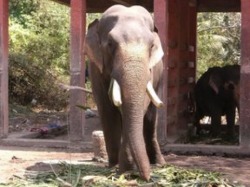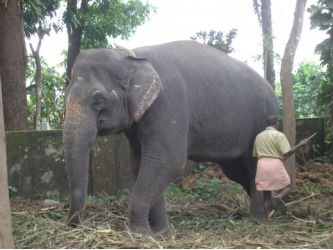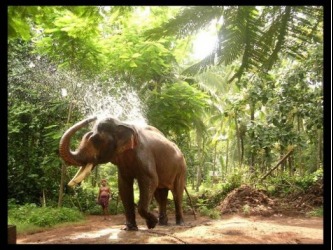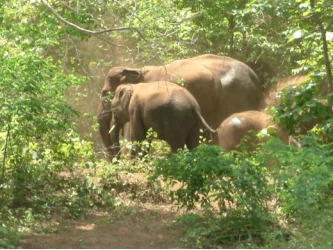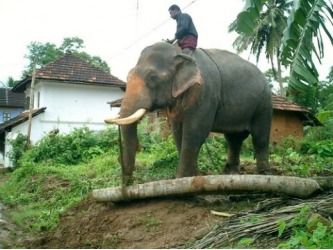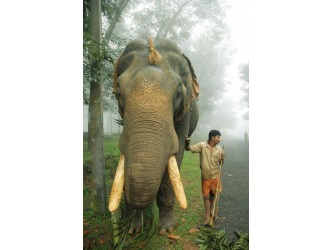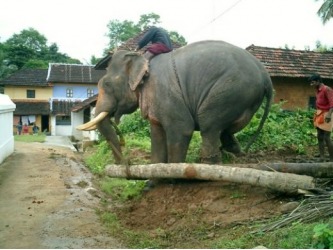Amazing Facts About Elephants
With Image Gallery at bottom
Elephant Fact and Festivals Elephant in Latin means Huge Arch ...
Ele means arch and phant means huge.Elephants are the largest living land animal in the
world. The huge mammals are endangered species due to poaching for ivory trade and
shrinking living space. They are keystones species affecting biodiversity of the place they inhabit.
They are divided into two species
1. Asian Elephant-Elephas Maximus
2. African Elephant-Loxodonta Africana Basic Diet
Elephants spend most time of a day for eating.Large stomach .Large appetite.
Digestive system is inefficient to absorb maximum nutrients. So they eat approximately 250Kg of food everyday and 150L of water.
Elephant's favored food includes coconut leaves, palm leaves, bananas, mangoes, coconut, sugar cane, bamboo, Pine apples, berries, corn, jungle shrubs, palm fruits, wood apples, rice and jaggery.
In Kerala, during Sukhachikitsa (Rejuvanation Therapy) Rice, Green gram, horse gram, Chyvanaprasam, Ashtachoornam, Turmeric powder, Tefroli powder, Sharkoferrol, Mineral mix and salt are given. Elephant Bath
Elephants love water. Elephants bath is a time consuming process for mahouts. In Kerala there may be 2 or 3 mahouts(pappan) for an elephant. They scrub the body of the elephant with coconut husks. This will remove the dirt and increase the blood circulation. Its very interesting to see this huge bath. Elephant will change its positions according to the instruction of 'Pappan'.
Aanayottam' (Elephant race)
The most famous Aanayottam is conducted at the Guruvayur temple during the Utsavam. This will start from 'Manjulalthara'(Big banyan tree in the eastern entrance). The race ends at the flag post. During the race the elephants have to run 7 times around the temple. The elephant who wins will have the right to take the idol of Sri Guruvayurappa during the procession.
'Aanayoottu' The ceremonial feeding of elephants. Nowadays its a common thing in almost all the processions of the temples. In this ritual medicinal food prepared specially to feed the elephants. During this ritual a lot of food is given to elephants and it leads to 'erandakettal' means constipation.
Coconut, jgggery, rice flakes, honey they are formed as a concrete like mix in his colon and this leads to his death. It is also observed that the food is given in plastic carry bags and this may also damage their health.
Gajapooja Worshipping of elephants. According to Puranas elephants are considered as incarnation of Mahaganapathy, the god who diminishes all obstacles. Vinayaka Chathurthy is an auspicious occasion for Ganapathy Temple. At Malliyoor Temple every year 'Gajapooja' and 'Aanayoottu' are observed as part of the Vinayaka Chathurthi rituals. Caparisoned jumbos are considered as the most eminent guests of the day. The feast of these pachyderms is a great pleasure to the devotees of the temple too. Bhagavatha Hamsam Malliyoor Namboothiri the great guru and the great devotee of Sri Guruvayurappa is conducting various events in the temple which attracts a lot of devotees from various places. It is the only temple, the diety is Sri krishna in the lap of Sri Mahaganapathy.
Gajamela Procession of caparisoned elephants. It may also be called as Elephant Pageantry. In Kerala Gajamela is a spectacular show of the beautiful elephants adorned with all the ornaments. The number of Gajamela is increasing every year most because of the commercialisation of the event. This attracts people from Kerala and abroad.
Aanaval Mothiram(The Ring)
This is ring made by the hairs of the elephant's tale. The hair is covered with gold. It is a common ornament in Kerala. Bracelets and bangles are also made in the same method. A strong belief exists that elephant hair ornaments will decrease the fear of our mind. Mostly these ornaments are used by children.
Aanakkottil (Elephant shed) Most of our religious festivals will be incomplete without elephants. Most of the temples have permanent facilities to incorporate elephants during festive seasons. Aanakkottil is the place where elephants will carry the idol and stay there for a long time for 'parayeduppu' or a 'panchavadyam'
Do You Know !!!
A baby elephant weigh almost 91Kg and almost have height of 9Meters.
- Female elephants are called cow
- Male elephants are called bull
- An adult elephant can eat 136Kg of food in a single day
- The heaviest tusk ever known belonged the Columbian mammoth these weighed 226kg!
- The other creature to have ivory teeth is the Walrus ( large sea animal living in the Arctic region).
Elephant Image Gallery
23,000 elephants killed each year for ivory
Up to 5 per cent of Africa’s elephants are being slaughtered for their ivory each year, according to research which suggests that poaching threatens the animals with extinction despite a global ban on the sale of ivory.
More than 23 tonnes of illegal ivory were seized between August 2005 and last August, most of it from recently killed elephants. Scientists believe that the true weight of smuggled tusks is ten times greater.
This would mean that about 234 tonnes of ivory were exported from Africa that year and about 23,000 elephants were killed. Continued poaching on this scale would drive the species rapidly to extinction.
Samuel Wasser, of the University of Washington in Seattle, who led the study, said the seizures suggested that poaching was taking place on a scale unseen since 1989, when an international convention banned the ivory trade.
The trend is being driven by growing demand in the Far East, and organised crime is becoming increasingly involved, Dr Wasser said. The black market price of a kilogram of good quality ivory was about $100 in 1989, and had doubled by 2004. However, last year a smuggled kilogram, was fetching $750 (£395), raising the financial incentive for poaching.
Urgent action is needed to help countries such as Zambia to deal with the organised crime syndicates that are running the trade, Dr Wasser said. “If it really is organised crime that’s driving this, then the only hope we have of stopping it is to stop the ivory at the source. . . because once it’s in the international market, the trade is very hard to stop.
“If people realised what is happening, they would be ashamed to be part of the crisis. We don’t want to spend our time catching criminals, we want to stop the crime from happening.”
The figures are disclosed today in the journal Proceedings of the National Academy of Sciences. The study team said it was estimated that quantities of contraband, such as illegal drugs, seized by customs amounted to about 10 per cent of the total smuggled. “We conservatively assume that this percentage is also the case for ivory,” they said.
“Most enforcement agencies do not ‘target’ ivory as they do drugs or weapons, and technological advances, such as drug scanners and detection dogs, do not help with the interception of contraband ivory. Thus, the above 23,461kg should correspond to 234,610kg of smuggled ivory from about 23,000 elephants killed this past year.”
Dr Wasser’s team used DNA analysis to trace the source of one of the largest shipments of ivory intercepted in recent years, a consignment of about 6.5 tonnes seized in Singapore in 2002. It contained 532 tusks, with an average weight of 11kg.
The shipment also included 42,120 ivory cylinders, known as hankos, which are used to make stamps bearing personal seals, and which carry great prestige in South Asia. The hankos alone were worth about $8.4 million.
The DNA signatures of 67 tusks showed that they had come from older elephants from the savannah of Zambia. The size of the shipment contradicts official claims that only 135 elephants have been killed illegally in Zambia over the past ten years.
The disclosures have already influenced policy in Zambia, but further action is needed, Dr Wasser said. “Subsequent to being informed of our findings, the Zambian Government
replaced its director of wildlife and began imposing significantly harsher sentences for convicted ivory traffickers.
“However, one still has to wonder whether this will be enough. Virtually no one has been prosecuted in this case.”
Genetic tracking of the origin of ivory should allow conservationists to protect elephants better where they are most at risk from poaching, he said, though international support was also needed. Western financial support for enforcing the ivory trade ban was largely withdrawn in 1993.
“What is really needed is to combine this with a major reinfusion of law enforcement aid at the scale that coincided with the 1989 ivory ban,” Dr Wasser said. “The international community virtually stopped ivory poaching once, and it can stop it again. Elephants are majestic animals and are not trivial to the ecosystem. They are a keystone species and taking them out significantly alters the habitat.”
White gold
— The number of African elephants decreased from 1.3 million in 1979 to 600,000 in 1989, when an international convention banned the trade of ivory. The population now stands at about 500,000
— Countries worst hit by poaching include Zambia, the Democratic Republic of Congo and Sudan Last year about 15 tonnes of ivory were seized — 10 to 15 per cent of the total traded
— An elephant carries about 7kg of ivory in its tusks
— About 60 to 70 per cent of ivory goes to the Far East, where it is used tomake name seals, tourist trinkets and carvings
Source: Born Free Foundation
video resource, www.youtube.com
THIS VIDEO NOT SUITABLE FOR
CHILDREN
Up to 5 per cent of Africa’s elephants are being slaughtered for their ivory each year, according to research which suggests that poaching threatens the animals with extinction despite a global ban on the sale of ivory.
More than 23 tonnes of illegal ivory were seized between August 2005 and last August, most of it from recently killed elephants. Scientists believe that the true weight of smuggled tusks is ten times greater.
This would mean that about 234 tonnes of ivory were exported from Africa that year and about 23,000 elephants were killed. Continued poaching on this scale would drive the species rapidly to extinction.
Samuel Wasser, of the University of Washington in Seattle, who led the study, said the seizures suggested that poaching was taking place on a scale unseen since 1989, when an international convention banned the ivory trade.
The trend is being driven by growing demand in the Far East, and organised crime is becoming increasingly involved, Dr Wasser said. The black market price of a kilogram of good quality ivory was about $100 in 1989, and had doubled by 2004. However, last year a smuggled kilogram, was fetching $750 (£395), raising the financial incentive for poaching.
Urgent action is needed to help countries such as Zambia to deal with the organised crime syndicates that are running the trade, Dr Wasser said. “If it really is organised crime that’s driving this, then the only hope we have of stopping it is to stop the ivory at the source. . . because once it’s in the international market, the trade is very hard to stop.
“If people realised what is happening, they would be ashamed to be part of the crisis. We don’t want to spend our time catching criminals, we want to stop the crime from happening.”
The figures are disclosed today in the journal Proceedings of the National Academy of Sciences. The study team said it was estimated that quantities of contraband, such as illegal drugs, seized by customs amounted to about 10 per cent of the total smuggled. “We conservatively assume that this percentage is also the case for ivory,” they said.
“Most enforcement agencies do not ‘target’ ivory as they do drugs or weapons, and technological advances, such as drug scanners and detection dogs, do not help with the interception of contraband ivory. Thus, the above 23,461kg should correspond to 234,610kg of smuggled ivory from about 23,000 elephants killed this past year.”
Dr Wasser’s team used DNA analysis to trace the source of one of the largest shipments of ivory intercepted in recent years, a consignment of about 6.5 tonnes seized in Singapore in 2002. It contained 532 tusks, with an average weight of 11kg.
The shipment also included 42,120 ivory cylinders, known as hankos, which are used to make stamps bearing personal seals, and which carry great prestige in South Asia. The hankos alone were worth about $8.4 million.
The DNA signatures of 67 tusks showed that they had come from older elephants from the savannah of Zambia. The size of the shipment contradicts official claims that only 135 elephants have been killed illegally in Zambia over the past ten years.
The disclosures have already influenced policy in Zambia, but further action is needed, Dr Wasser said. “Subsequent to being informed of our findings, the Zambian Government
replaced its director of wildlife and began imposing significantly harsher sentences for convicted ivory traffickers.
“However, one still has to wonder whether this will be enough. Virtually no one has been prosecuted in this case.”
Genetic tracking of the origin of ivory should allow conservationists to protect elephants better where they are most at risk from poaching, he said, though international support was also needed. Western financial support for enforcing the ivory trade ban was largely withdrawn in 1993.
“What is really needed is to combine this with a major reinfusion of law enforcement aid at the scale that coincided with the 1989 ivory ban,” Dr Wasser said. “The international community virtually stopped ivory poaching once, and it can stop it again. Elephants are majestic animals and are not trivial to the ecosystem. They are a keystone species and taking them out significantly alters the habitat.”
White gold
— The number of African elephants decreased from 1.3 million in 1979 to 600,000 in 1989, when an international convention banned the trade of ivory. The population now stands at about 500,000
— Countries worst hit by poaching include Zambia, the Democratic Republic of Congo and Sudan Last year about 15 tonnes of ivory were seized — 10 to 15 per cent of the total traded
— An elephant carries about 7kg of ivory in its tusks
— About 60 to 70 per cent of ivory goes to the Far East, where it is used tomake name seals, tourist trinkets and carvings
Source: Born Free Foundation
video resource, www.youtube.com
THIS VIDEO NOT SUITABLE FOR
CHILDREN

